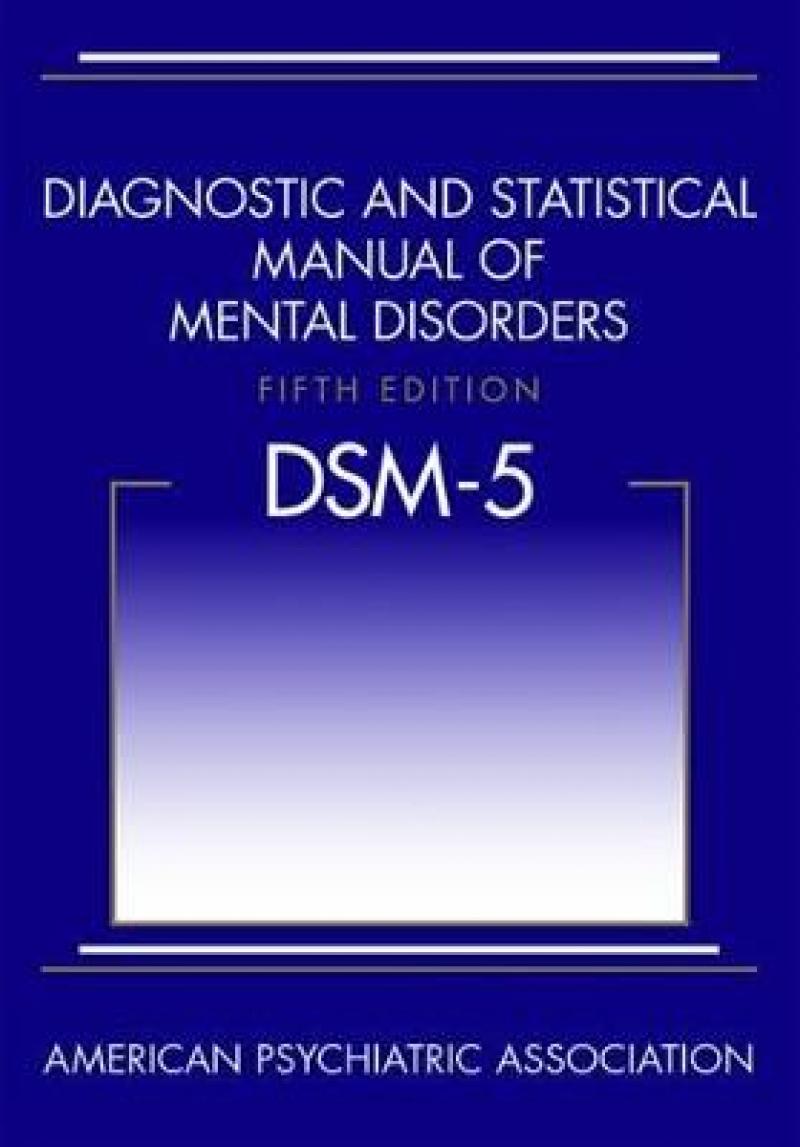This new edition of Diagnostic and Statistical Manual of Mental Disorders (DSM-5), used by clinicians and researchers to diagnose and classify mental disorders, is the product of more than 10 years of effort by hundreds of international experts in all aspects of mental health. Their dedication and hard work have yielded an authoritative volume that defines and classifies mental disorders in order to improve diagnoses, treatment, and research.
The criteria are concise and explicit, intended to facilitate an objective assessment of symptom presentations in a variety of clinical settings—inpatient, outpatient, partial hospital, consultation-liaison, clinical, private practice, and primary care. New features and enhancements make DSM-5 easier to use across all settings:
• The chapter organization reflects a lifespan approach, with disorders typically diagnosed in childhood (such as neurodevelopmental disorders) at the beginning of the manual, and those more typical of older adults (such as neurocognitive disorders) placed at the end. Also included are age-related factors specific to diagnosis. • The latest findings in neuroimaging and genetics have been integrated into each disorder along with gender and cultural considerations.• The revised organizational structure recognizes symptoms that span multiple diagnostic categories, providing new clinical insight in diagnosis. • Specific criteria have been streamlined, consolidated, or clarified to be consistent with clinical practice (including the consolidation of autism disorder, Asperger's syndrome, and pervasive developmental disorder into autism spectrum disorder; the streamlined classification of bipolar and depressive disorders; the restructuring of substance use disorders for consistency and clarity; and the enhanced specificity for major and mild neurocognitive disorders).• Dimensional assessments for research and validation of clinical results have been provided.• Both ICD-9-CM and ICD-10-CM codes are included for each disorder, and the organizational structure is consistent with the new ICD-11 in development.
The Diagnostic and Statistical Manual of Mental Disorders, Fifth Edition, is the most comprehensive, current, and critical resource for clinical practice available to today's mental health clinicians and researchers of all orientations. The information contained in the manual is also valuable to other physicians and health professionals, including psychologists, counselors, nurses, and occupational and rehabilitation therapists, as well as social workers and forensic and legal specialists.
Les mer
This new edition of the American Psychiatric Association's Diagnostic and Statistical Manual of Mental Disorders (DSM-5), used by clinicians and researchers to diagnose and classify mental disorders, is an authoritative volume that improves diagnoses, treatment, and research.
Les mer
DSM-5 ClassificationPrefaceSection I: DSM-5 BasicsChapter 1. IntroductionChapter 2. Use of the ManualChapter 3. Cautionary Statement for Forensic Use of DSM-5Section II: Diagnostic Criteria and CodesChapter 4. Neurodevelopmental DisordersChapter 5. Schizophrenia Spectrum and Other Psychotic DisordersChapter 6. Bipolar and Related DisordersChapter 7. Depressive DisordersChapter 8. Anxiety DisordersChapter 9. Obsessive-Compulsive and Related DisordersChapter 10. Trauma- and Stressor-Related DisordersChapter 11. Dissociative DisordersChapter 12. Somatic Symptom and Related DisordersChapter 13. Feeding and Eating DisordersChapter 14. Elimination DisordersChapter 15. Sleep-Wake DisordersChapter 16. Sexual DysfunctionsChapter 17. Gender DysphoriaChapter 18. Disruptive, Impulse-Control, and Conduct Disorders Chapter 19. Substance-Related and Addictive DisordersChapter 20. Neurocognitive DisordersChapter 21. Personality DisordersChapter 22. Paraphilic DisordersChapter 23. Other Mental DisordersChapter 24. Medication-Induced Movement Disorders and Other Adverse Effects of MedicationChapter 25. Other Conditions That May Be a Focus of Clinical AttentionSection III: Emerging Measures and ModelsChapter 26. Assessment MeasuresChapter 27. Cultural FormulationChapter 28. Alternative DSM-5 Model for Personality DisordersChapter 29. Conditions for Further StudyAppendix:Highlights of Changes From DSM-IV to DSM-5Glossary of Technical TermsGlossary of Cultural Concepts of DistressAlphabetical Listing of DSM-5 Diagnoses and Codes (ICD-9-CM and ICD-10-CM)Numerical Listing of DSM-5 Diagnoses and Codes (ICD-9-CM)Numerical Listing of DSM-5 Diagnoses and Codes (ICD-10-CM)DSM-5 Advisors and Other ContributorsIndex
Les mer
This new edition of the American Psychiatric Association's Diagnostic and Statistical Manual of Mental Disorders (DSM-5), used by clinicians and researchers to diagnose and classify mental disorders, is the product of more than 10 years of effort by hundreds of international experts in all aspects of mental health. Their dedication and hard work have yielded an authoritative volume that defines and classifies mental disorders in order to improve diagnoses, treatment, and research. This manual, which creates a common language for clinicians involved in the diagnosis of mental disorders, includes concise and specific criteria intended to facilitate an objective assessment of symptom presentations in a variety of clinical settings—inpatient, outpatient, partial hospital, consultation-liaison, clinical, private practice, and primary care.
The Diagnostic and Statistical Manual of Mental Disorders, Fifth Edition, is the most comprehensive, current, and critical resource for clinical practice available to today's mental health clinicians and researchers of all orientations. The information contained in the manual is also valuable to other physicians and health professionals, including psychologists, counselors, nurses, and occupational and rehabilitation therapists, as well as social workers and forensic and legal specialists. DSM-5 is the most definitive resource for the diagnosis and classification of mental disorders.
Les mer
DSM-5 has been underused and underappreciated as a source of commentary and context for the disorders whose boundaries it defines. In fact, there is much to admire in the content as well as the design of the volume. All too often trainees, busy clinicians, and educators alike skip hurriedly past its hundreds of pages of text to locate the boxed criterion sets that have come to be seen as the primary function of the manual. In doing so, they miss a rich set of clinical descriptions, conceptual frameworks, and related information regarding the disorders described. Treated not as a manual but as a textbook of clinical pathology, DSM-5 proves to be a thorough, authoritative, and respectably well-written addition to the genre." - Michael D. Jibson & Lisa S. Seyfried, University of Michigan, Ann Arbor, MI, USA, Academic Psychiatry
Les mer
Produktdetaljer
ISBN
9780890425558
Publisert
2013-07-21
Utgave
5. utgave
Utgiver
Vendor
American Psychiatric Association Publishing
Vekt
1501 gr
Høyde
254 mm
Bredde
175 mm
Dybde
44 mm
Aldersnivå
P, 06
Språk
Product language
Engelsk
Format
Product format
Heftet
Antall sider
991
